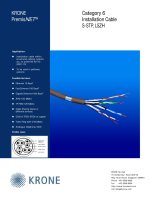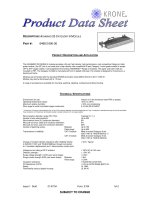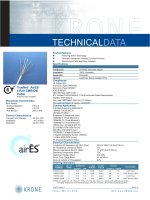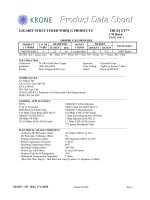Cat 6 White Paper FINAL 8-15-02
Bạn đang xem bản rút gọn của tài liệu. Xem và tải ngay bản đầy đủ của tài liệu tại đây (146.4 KB, 9 trang )
Category 6 Cabling:
A Standards and Systems Overview
Published by the Category 6 Consortium
Telecommunications Industry Association
August 2002
Category 6 Cabling: A Standards and Systems Overview 1
About the Category 6 Initiative
The following white paper was produced by participants of the Category 6 Consortium. This con-
sortium — focused on category 6 cabling systems — has assisted in development of generic stan-
dards primarily for balanced twisted-pair cabling systems. These standards cover balanced twist-
ed-pair cable and associated connecting hardware specifications, including test procedures, per-
formance requirements and test instrument requirements. In development of these standards, the-
oretical models and controlled experimentation were used to validate link and channel specifica-
tions via component requirements.
On June 20, 2002 TIA published the category 6 addition to the TIA-568 standard, which has the
official document number of ANSI/TIA/EIA-568-B.2-1. The Category 6 Consortium has been
formed to promote the adoption of category 6. To begin this initiative, the Category 6 Consortium
is releasing this white paper to provide industry participants with an update on category 6 cabling
and applications standards, as well as additional references for finding category 6 information
and products. It is important to note that any opinions expressed in this document are those of
the participants of the Category 6 Consortium and are not necessarily those of the entire TIA
membership.
For more information about category 6, please visit the TIA Web site at ,
or contact Andy Dryden at (703) 907-7633.
Category 6 Cabling: A Standards and Systems Overview
Published by the Category 6 Consortium
IInnttrroodduuccttiioonn
Structured cabling has grown globally into a $4 billion market and is expected to continue grow-
ing at about a 4 percent compound annual growth rate, according to leading independent ana-
lysts*. Category 6 cabling is the latest addition to the structured cabling standards and has twice
the bandwidth of category 5e cabling. This improved bandwidth, together with vastly improved
immunity from external noise, provides the potential for category 6 to support multi-gigabit
applications. This white paper provides an update on category 6 cabling and applications stan-
dards together with references for finding category 6 information and products.
Topics highlighted include:
• Background for ANSI/TIA/EIA-568-B.2-1
• Quick comparison of category 5, 5e and 6 standards requirements
• Key features of the category 6 standard
• Review of standards applicable to category 6
• Category 6 market penetration
• TIA press release on category 6 standard
• References for category 6 information
• Category 6 Consortium participant URLs for product information
AANNSSII//TTIIAA//EEIIAA--556688--BB..22--11 ppuubblliisshheedd oonn JJuunnee 2200,, 22000022
The TIA TR-42.7 Copper Cabling Systems Committee unanimously approved the publication of the
category 6 standard on June 5, 2002, and it was published on June 20. This represents the con-
sensus of 46 telecommunications cabling manufacturers, consultants and users who submitted
ballot comments during the industry ballot, as well as several others who regularly participate in
the committee. The document contains category 6 end-to-end cabling specifications, component
specifications, field tester requirements and measurement procedures, together with accuracy and
reproducibility guidelines that ensure a reliable cabling system. The standard satisfies all the origi-
nal objectives established by TR-42.1 (formerly TR-41.8.1) at the outset of the PN-3727 project
including:
• Backward compatibility to categories 5e, 5 and 3
• Open standard that allows products from different vendors to work together
• Patch cord plug and jack interoperability for modular (RJ-45 type) connections
• Full system specification including testing of components, patch cords, channels and per-
manent links
• Twice the bandwidth of category 5e with positive Power Sum Attenuation to Cross-Talk
Ratio (PSACR) up to 200 MHz
• All specifications for components and cabling are tested to 250 MHz
Category 6 Cabling: A Standards and Systems Overview 2
*CIM Volume 10 Issue 5, May 2002, Market Trends by BSRIA
The TIA press release following this white paper contains additional information on the publica-
tion of ANSI/TIA-568-B.2-1. Also attached is a list of manufacturers that contributed to early
Category 6 Consortium discussions and offer category 6 cabling systems, category 6 components,
field testers or other services to support category 6.
AA QQuuiicckk CCoommppaarriissoonn ooff CCaatteeggoorryy 55,, 55ee aanndd 66 SSttaannddaarrddss RReeqquuiirreemmeennttss
KKeeyy FFeeaattuurreess ooff tthhee CCaatteeggoorryy 66 SSttaannddaarrdd
Following are the top three areas that required new development work for the category 6 specifi-
cations.
• Test plug qualification for near-end crosstalk (NEXT) and far-end crosstalk (FEXT). This is the
fundamental basis for plug and jack interoperability between manufacturers.
• Patch cord performance requirements and test specifications. Patch cord testing is key to
ensuring interoperability. This has been included in the category 6 standard as a funda-
mental requirement and not as an addendum, as was the case for category 5e.
4 Category 6 Cabling: A Standards and Systems Overview
As of TIA Cat 5 TIA Cat 5e TIA Cat 6
6/18/2002 TIA-568-A TIA-568-B TIA-568-B.2-1
Oct-95
(Obsolete)
Final Final
May-01 Jun-02
Maximum Test
Frequency
(dB) (dB) (dB)
Cable 22 22 19.8
Connector 0.4 0.4 0.2
Channel 24 24 21.3
Cable not specified 35.3 44.3
Connector not specified 43.0 54.0
Channel not specified 30.1 39.9
Cable not specified 23.8 27.8
Connector not specified 35.1 43.1
Channel not specified 17.4 23.3
Cable 16.0 (SRL) 20.1 20.1
Connector 14.0 20.0 24.0
Channel 8.0 10.0 12.0
Insertion Loss* (The lower the number, the better solution)
*Also referred to as Attenuation
NEXT (The higher the number, the better solution)
ELFEXT (The higher the number, the better solution)
Return Loss (The higher the number, the better solution)
100 MHz 100 MHz 250 MHz
Values @ 100 MHz:
• Measurement procedures for connecting hardware NEXT and FEXT. These procedures
required the creation of brand new fixtures, calibration procedures and many refinements
to ensure repeatability in different laboratories.
OOtthheerr SSttaannddaarrddss AApppplliiccaabbllee ttoo CCaatteeggoorryy 66
ISO/IEC 1
180
1
The second edition of the ISO/IEC 11801 standard includes category 6 components as well as
cabling. In ISO/IEC 11801, category 6 cabling is referred to as “Class E Cabling.” It is expected that
the ISO/IEC 11801 document will be published sometime in the fourth quarter of 2002.
The category 6 specifications in the ISO/IEC 11801 document are essentially the same as in
ANSI/TIA-568-B.2-1. This allows manufacturers and customers to choose category 6 cabling sys-
tems that have the same performance anywhere in the world to support all emerging applica-
tions.
CENELEC EN-50
173
The second edition of the EN 50173 standard also includes category 6 components as well as
cabling. It is expected that the EN 50173 document will be published sometime in the fourth
quarter of 2002.
The category 6 specifications included in the EN 50173 second edition are essentially the same as
in ANSI/TIA-568-B.2-1 and the ISO/IEC 11801 second edition to facilitate global compatibility of
cabling and emerging applications.
ANSI/TIA-854 1
000BASE-TX Standard for Gigabit Ethernet over Category 6 Cabling
The ANSI/TIA-854 standard, “A Full Duplex Ethernet Physical Layer Specification for 1000Mbit/s
(1000BASE-TX) Operating over Category 6 Balanced Twisted-Pair Cabling,” published in March
2001, provides a data rate of 1000 Megabits/second, similar to the IEEE 802.3ab Gigabit Ethernet
standard. The main difference is that it requires category 6 cabling instead of category 5e cabling.
Because of the improved performance of category 6 cabling, the ANSI/TIA-854 standard does not
implement NEXT cancellation or echo cancellation, and therefore reduces the cost, complexity and
power consumption of TIA-854 chipsets compared to IEEE 1000BASE-T chipsets.
A
TM Forum LAN Standards
The ATM Forum published the cell-based ATM FB-PHY-0162.000 standard in January 2001. This
standard provides a 1000 Megabits/second data rate over standard category 6 channels of 100
meters using the standard ATM cell format. This standard is now included in the ISO/IEC 11801
list of recognized application standards for Class E (category 6). The ATM version of the Gigabit
standard provides seamless connectivity between LAN, MAN and WAN networks that use the ATM
protocol.
Other Application Committees
Now that the category 6 installed base is poised to quickly overtake the category 5e installed
base, there is interest in using category 6 cabling in several other application committees. This
work should gain momentum in the next few months, with new projects expected to be
announced to develop applications faster than 1 Gigabit over 100 meters of standardized category
6 cabling.
Category 6 Cabling: A Standards and Systems Overview 4









